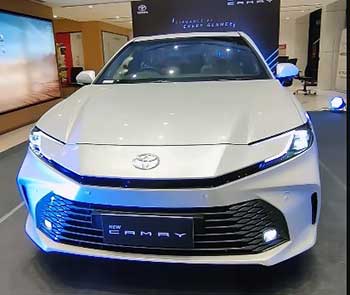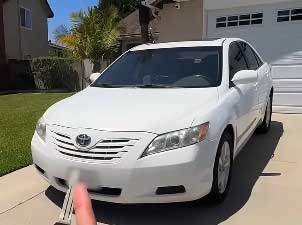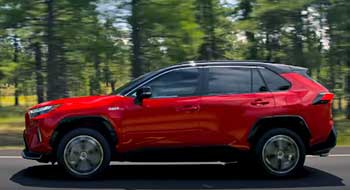
I’ve always been a Toyota fan, drawn to their reliability and practicality, but choosing between the 2025 Toyota Camry and RAV4 was a tough call.
As a driver who values comfort, efficiency, and versatility, I wanted to explore which vehicle suits my lifestyle—and maybe yours too.
This article compares these two iconic models, breaking down their pros, cons, and maintenance needs while sharing my firsthand experience.
Whether you’re commuting or adventuring, I’ll help you decide which Toyota is your ideal match through a detailed, conversational analysis.
Comparison Table: Camry Vs. RAV4
| Feature | 2025 Toyota Camry | 2025 Toyota RAV4 |
|---|---|---|
| Base Price | $29,895 | $31,000 |
| Fuel Economy (City/Hwy/Combined) | 53/50/52 MPG (Hybrid LE) | 41/38/39 MPG (Hybrid) |
| Passenger Volume | 99.9 cu. ft. | 98.9 cu. ft. |
| Cargo Volume | 15.1 cu. ft. | 69.8 cu. ft. (seats folded) |
| Ground Clearance | 5.7 inches | 8.8 inches |
| Powertrain Options | 2.5L 4-cyl, Hybrid, 3.5L V6 | 2.5L 4-cyl, Hybrid, PHEV |
| Horsepower | 225 hp (Hybrid), 301 hp (V6) | 219 hp (Hybrid), 302 hp (Prime) |
| Towing Capacity | Not recommended | Up to 3,500 lbs (Adventure/TRD) |
| Drive Options | FWD, AWD | FWD, AWD |
| Safety Features | Toyota Safety Sense 3.0 | Toyota Safety Sense 2.5 |
| Infotainment | 8.0-inch touchscreen, Wireless CarPlay/Android Auto | 8.0-inch touchscreen, Wireless CarPlay/Android Auto |
My Experience With The Camry
I’ll never forget the first time I slid into the driver’s seat of a 2025 Toyota Camry Hybrid XLE. The cabin felt like a cozy, high-tech cocoon—soft-touch materials, a sleek 8.0-inch touchscreen, and a driver’s seat that hugged me just right. Driving through city traffic was a breeze; the Camry’s tight 39.4-foot turning circle made navigating tight corners feel effortless, almost like I was piloting a much smaller car. On the highway, the hybrid’s 52 MPG combined fuel economy let me cruise from Pittsburgh to Philadelphia without a single gas station stop, saving me both time and money.
The Camry’s smooth ride was a standout. Its suspension soaked up bumps like they were nothing, and the cabin stayed whisper-quiet, even at 70 mph. I tested the AWD version during a rainy weekend, and while it didn’t match the RAV4’s off-road prowess, it gripped the road confidently. The Toyota Safety Sense 3.0 suite, with its adaptive cruise control and lane-tracing assist, made long drives feel less taxing.
However, the 15.1-cubic-foot trunk, while decent for groceries or luggage, felt limiting when I tried loading camping gear for a weekend trip. I also noticed the base model lacked rain-sensing wipers, which was a minor annoyance in unpredictable weather.
For commuting and solo drives, the Camry felt like an extension of myself—refined, efficient, and reliable. But when I needed to haul more gear or tackle rougher roads, I found myself wishing for the RAV4’s versatility. The Camry’s sporty XSE trim, with its 19-inch wheels and tuned suspension, added some fun to twisty roads, but it still couldn’t match the RAV4’s go-anywhere vibe. Ultimately, the Camry was perfect for my daily grind but left me wanting more for adventurous weekends.
Pros Of The Camry

- Fuel Efficiency: The Camry Hybrid LE’s 52 MPG combined is a game-changer for long commutes, saving significant fuel costs compared to the RAV4’s 39 MPG hybrid.
- Smooth Ride: Its refined suspension and quiet cabin make city and highway driving comfortable, ideal for professionals or families seeking a serene experience.
- Affordable Base Price: Starting at $29,895, the Camry is cheaper than the RAV4’s $31,000, offering better value for budget-conscious buyers.
- Spacious Passenger Area: With 99.9 cubic feet of passenger volume, the Camry offers more legroom (42.1 inches front, 38.0 inches rear) than the RAV4, perfect for taller passengers.
- Advanced Safety Features: Toyota Safety Sense 3.0 includes enhanced pre-collision braking and bicyclist detection, providing superior safety for urban driving.
- Variety Of Trims: From the economical LE to the sporty TRD with a 301-hp V6, the Camry caters to diverse preferences, unlike the RAV4’s more uniform lineup.
- Lower Maintenance Costs: Averaging $1,900 over five years, the Camry is cheaper to maintain than the RAV4’s $2,250, easing long-term ownership costs.
The Camry shines as a commuter’s dream, blending efficiency, comfort, and affordability. Its hybrid system delivers stellar gas mileage, and the spacious interior ensures everyone rides in comfort. Whether you’re dodging city traffic or cruising highways, the Camry’s smooth handling and advanced safety tech keep you confident. The range of trims lets you pick your flavor—budget-friendly or performance-driven.
Cons Of The Camry
- Limited Cargo Space: The 15.1-cubic-foot trunk struggles with bulky items like bikes or camping gear, making it less practical than the RAV4’s 69.8 cubic feet.
- No Towing Capability: Toyota doesn’t recommend towing with the Camry, limiting its utility compared to the RAV4’s 3,500-pound capacity in higher trims.
- Lower Ground Clearance: At 5.7 inches, the Camry can scrape on rough roads or deep snow, unlike the RAV4’s 8.8 inches.
- No Plug-In Hybrid Option: Unlike the RAV4 Prime’s 42-mile electric range, the Camry lacks a PHEV, limiting eco-friendly options.
- Less Versatile For Off-Road: Even with AWD, the Camry isn’t suited for unpaved roads, unlike the RAV4’s Adventure or TRD Off-Road trims.
- Basic Infotainment In Base Model: The LE’s 8.0-inch touchscreen lacks the premium feel of higher trims, and no rain-sensing wipers feels like a miss.
- Sedan Stigma: The Camry’s “taxi” association may deter buyers seeking a trendier SUV image, despite its modern design.
While the Camry excels in efficiency and comfort, its sedan design limits its versatility. The small trunk and lack of towing make it less ideal for families or adventurers. Its low ground clearance and absence of a plug-in hybrid also put it behind the RAV4 for those needing more flexibility or eco-conscious options.
Maintenance Tips For The Camry
- Regular Oil Changes: Stick to synthetic oil changes every 7,500 miles or six months to keep the 2.5L or V6 engine running smoothly, extending its lifespan.
- Tire Rotations: Rotate tires every 5,000-7,500 miles to ensure even wear, especially with AWD models, to maintain handling and fuel efficiency.
- Brake Inspections: Check brake pads and rotors every 15,000 miles, as city driving can wear them faster; replace pads around 30,000-50,000 miles.
- Battery Maintenance: For hybrids, inspect the 12-volt battery annually and ensure the cooling system for the hybrid battery is debris-free to avoid overheating.
- Fluid Checks: Monitor coolant, transmission fluid, and brake fluid levels every 10,000 miles to prevent costly repairs and maintain performance.
- Air Filter Replacement: Replace cabin and engine air filters every 15,000-20,000 miles to improve air quality and engine efficiency, especially in dusty areas.
- Wiper Blade Replacement: Swap wiper blades every 6-12 months to ensure clear visibility, as the Camry lacks rain-sensing wipers in base models.
Maintaining a Camry is straightforward, thanks to Toyota’s reliability. Regular oil changes and tire rotations keep it running like a dream, while brake and fluid checks prevent surprises. For hybrids, extra attention to the battery system ensures longevity. These steps keep costs low—around $1,900 over five years—and your Camry ready for the road.
My Experience With The RAV4
Switching to the 2025 Toyota RAV4 Hybrid XLE felt like stepping into a different world. The higher seating position gave me a commanding view of the road, making freeway merges in busy traffic feel less stressful.
I took it on a camping trip to the Poconos, and the 69.8 cubic feet of cargo space (with seats folded) easily swallowed my tent, cooler, and bike without a hitch. The 8.8-inch ground clearance handled bumpy forest roads like a champ, something the Camry would’ve struggled with.
The RAV4’s hybrid powertrain, delivering 219 hp, felt snappy off the line, and its 39 MPG combined was impressive for an SUV. The standard AWD gave me confidence on wet trails, and the Toyota Safety Sense 2.5 suite, while slightly less advanced than the Camry’s 3.0, still kept me safe with features like lane departure alerts.
However, the cabin was noisier than the Camry’s, especially on highways, and the ride felt stiffer over potholes. The infotainment system matched the Camry’s, but the base LE’s single USB port was a letdown for my tech-heavy trips.
The RAV4 was my go-to for adventures, offering space and capability the Camry couldn’t match. But for daily commutes, its firmer ride and higher price tag ($31,000 vs. $29,895) made me miss the Camry’s refinement. It’s a versatile beast, but not as polished for long, urban drives.
Pros Of The RAV4

- Spacious Cargo Area: With 37.6 cubic feet behind the rear seats and 69.8 with them folded, the RAV4 easily handles bikes, camping gear, or groceries.
- Higher Ground Clearance: At 8.8 inches, it tackles rough roads, snow, or light off-roading better than the Camry’s 5.7 inches.
- Towing Capability: Adventure and TRD Off-Road trims tow up to 3,500 pounds, ideal for small trailers or boats, unlike the Camry.
- Standard AWD In Hybrids: The hybrid’s AWD enhances traction in adverse conditions, making it more versatile than the Camry’s optional AWD.
- Plug-In Hybrid Option: The RAV4 Prime’s 42-mile electric range and 302 hp offer eco-friendly power the Camry lacks.
- Better Visibility: The higher seating position improves road visibility, reducing blind spots compared to the Camry’s lower stance.
- Adventure-Ready Trims: Adventure and TRD Off-Road models cater to outdoor enthusiasts with rugged styling and off-road tuning.
The RAV4’s versatility makes it a family favorite or adventurer’s choice. Its cargo space, towing capacity, and ground clearance outshine the Camry for those needing a do-it-all vehicle. The plug-in hybrid and AWD options add eco-friendly and all-weather capability, perfect for diverse lifestyles.
Cons Of The RAV4
- Higher Base Price: Starting at $31,000, the RAV4 is pricier than the Camry’s $29,895, which may strain budgets.
- Lower Fuel Economy: The hybrid’s 39 MPG combined lags behind the Camry’s 52 MPG, increasing fuel costs for commuters.
- Noisier Cabin: Rear wheel noise is more noticeable than in the Camry, especially on highways, reducing comfort.
- Stiffer Ride: The RAV4’s suspension feels firmer over bumps, less refined than the Camry’s smooth ride.
- Lower Safety Rating: It scores 4 stars for frontal crash and rollover tests, compared to the Camry’s 5-star ratings across the board.
- Limited Base Features: The LE trim has only one USB port and lacks premium touches like rain-sensing wipers, unlike higher trims.
- Higher Maintenance Costs: Averaging $2,250 over five years, it’s costlier to maintain than the Camry’s $1,900.
The RAV4’s SUV advantages come with trade-offs. Its higher price, noisier cabin, and lower fuel economy make it less ideal for daily commutes compared to the Camry. The stiffer ride and slightly lower safety ratings might also give pause to comfort-focused or safety-conscious buyers.
Maintenance Tips For The RAV4
- Oil Changes: Use synthetic oil and change every 7,500 miles or six months to keep the 2.5L engine or hybrid system in top shape.
- Tire Maintenance: Rotate tires every 5,000-7,500 miles, especially for AWD models, to ensure even wear and maintain traction on rough terrain.
- Brake System Checks: Inspect brakes every 15,000 miles; replace pads around 30,000-50,000 miles, as SUVs endure more stress from cargo weight.
- Hybrid Battery Care: Check the hybrid battery’s cooling system annually to prevent overheating, ensuring longevity of the 150,000-mile warranty.
- Fluid Levels: Monitor coolant, transmission, and differential fluid (for AWD) every 10,000 miles to avoid performance issues on rugged roads.
- Air Filter Replacement: Swap engine and cabin air filters every 15,000-20,000 miles to maintain efficiency and air quality, crucial for off-road driving.
- Suspension Inspection: Check shocks and struts every 20,000 miles, as the RAV4’s higher clearance and off-road use can accelerate wear.
The RAV4’s maintenance is similar to the Camry’s but requires extra attention to AWD components and the hybrid battery. Regular checks keep costs around $2,250 over five years and ensure reliability, whether you’re on city streets or forest trails.
Read more: My Thoughts on Honda Odyssey Vs. Subaru Ascent
Frequently Asked Questions (FAQ)
It depends on your needs. The Camry excels for commuters with its 52 MPG and smooth ride, while the RAV4 suits families or adventurers with its cargo space and 8.8-inch ground clearance.
The RAV4 has a higher $31,000 base price, lower 39 MPG fuel economy, noisier cabin, stiffer ride, and 4-star safety ratings compared to the Camry’s 5 stars.
The Camry’s popularity stems from its reliability, 52 MPG hybrid efficiency, spacious interior, affordable $29,895 price, and advanced safety features like Toyota Safety Sense 3.0.
Yes, the Camry is longer at 192.1 inches compared to the RAV4’s 180.9 inches, but the RAV4 is taller and wider, offering more cargo space.
Conclusion: For Camry And RAV4
You’re probably wondering which Toyota is right for you, and I get it—it’s a tough choice. If your life revolves around city commutes, long highway drives, or solo trips, the Camry’s fuel efficiency, smooth ride, and lower price make it a no-brainer. It’s like a trusted friend who’s always ready for the daily grind. But if you’re hauling kids, pets, or camping gear, or you crave adventure on rough roads, the RAV4’s cargo space, towing capability, and rugged design are hard to beat. Both are reliable, but your lifestyle decides the winner.

